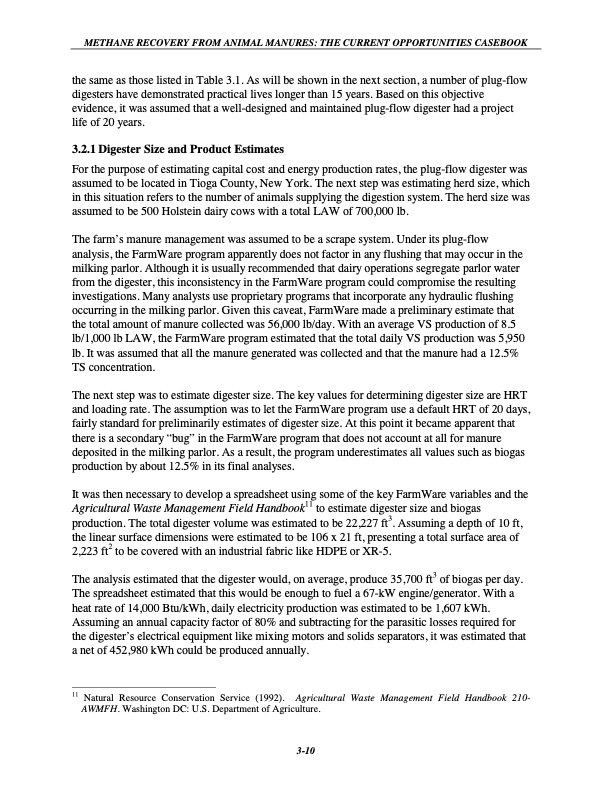
PDF Publication Title:
Text from PDF Page: 051
METHANE RECOVERY FROM ANIMAL MANURES: THE CURRENT OPPORTUNITIES CASEBOOK the same as those listed in Table 3.1. As will be shown in the next section, a number of plug-flow digesters have demonstrated practical lives longer than 15 years. Based on this objective evidence, it was assumed that a well-designed and maintained plug-flow digester had a project life of 20 years. 3.2.1 Digester Size and Product Estimates For the purpose of estimating capital cost and energy production rates, the plug-flow digester was assumed to be located in Tioga County, New York. The next step was estimating herd size, which in this situation refers to the number of animals supplying the digestion system. The herd size was assumed to be 500 Holstein dairy cows with a total LAW of 700,000 lb. The farm’s manure management was assumed to be a scrape system. Under its plug-flow analysis, the FarmWare program apparently does not factor in any flushing that may occur in the milking parlor. Although it is usually recommended that dairy operations segregate parlor water from the digester, this inconsistency in the FarmWare program could compromise the resulting investigations. Many analysts use proprietary programs that incorporate any hydraulic flushing occurring in the milking parlor. Given this caveat, FarmWare made a preliminary estimate that the total amount of manure collected was 56,000 lb/day. With an average VS production of 8.5 lb/1,000 lb LAW, the FarmWare program estimated that the total daily VS production was 5,950 lb. It was assumed that all the manure generated was collected and that the manure had a 12.5% TS concentration. The next step was to estimate digester size. The key values for determining digester size are HRT and loading rate. The assumption was to let the FarmWare program use a default HRT of 20 days, fairly standard for preliminarily estimates of digester size. At this point it became apparent that there is a secondary “bug” in the FarmWare program that does not account at all for manure deposited in the milking parlor. As a result, the program underestimates all values such as biogas production by about 12.5% in its final analyses. It was then necessary to develop a spreadsheet using some of the key FarmWare variables and the 11 Agricultural Waste Management Field Handbook to estimate digester size and biogas 3 production. The total digester volume was estimated to be 22,227 ft . Assuming a depth of 10 ft, the linear surface dimensions were estimated to be 106 x 21 ft, presenting a total surface area of 2 2,223ft tobecoveredwithanindustrialfabriclikeHDPEorXR-5. 3 Theanalysisestimatedthatthedigesterwould,onaverage,produce35,700ft ofbiogasperday. The spreadsheet estimated that this would be enough to fuel a 67-kW engine/generator. With a heat rate of 14,000 Btu/kWh, daily electricity production was estimated to be 1,607 kWh. Assuming an annual capacity factor of 80% and subtracting for the parasitic losses required for the digester’s electrical equipment like mixing motors and solids separators, it was estimated that a net of 452,980 kWh could be produced annually. 11 AWMFH. Washington DC: U.S. Department of Agriculture. Natural Resource Conservation Service (1992). Agricultural Waste Management Field Handbook 210- 3-10PDF Image | Methane Recovery from Animal Manures The Current Opportunities Casebook

PDF Search Title:
Methane Recovery from Animal Manures The Current Opportunities CasebookOriginal File Name Searched:
biogas02.pdfDIY PDF Search: Google It | Yahoo | Bing
Capstone Turbine and Microturbine: Capstone microturbines used and new surplus for sale listing More Info
Consulting and Strategy Services: Need help with Capstone Turbine, sizing systems, applications, or renewable energy strategy, we are here to assist More Info
Container Lumber Dry Kiln: Since 1991 developing and innovating dry kilns using standard shipping containers More Info
Supercritical CO2 Lumber Dry Kiln: Compact fast drying in 3 days or less for small amounts of wood and lumber drying More Info
BitCoin Mining: Bitcoin Mining and Cryptocurrency... More Info
Publications: Capstone Turbine publications for microturbine and distributed energy More Info
FileMaker Software for Renewable Energy Developing database software for the renewable energy industry More Info
CO2 Gas to Liquids On-Demand Production Cart Developing a supercritical CO2 to alcohol on-demand production system (via Nafion reverse fuel cell) More Info
Stranded Gas for low cost power Bitcoin Mining Using stranded gas for generators may provide breakthrough low power costs for cryptocurrency miners. More Info
| CONTACT TEL: 608-238-6001 Email: greg@globalmicroturbine.com | RSS | AMP |